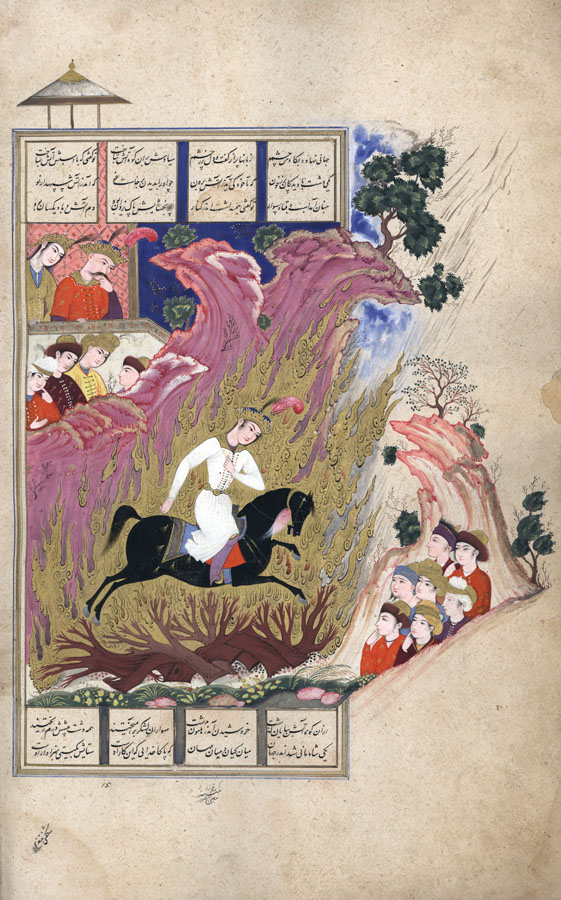The Fire Ordeal of Siyāvoš
In the foreground of the painting is a narrow strip of vegetation interspersed with stones, on which is piled a pyre of tree trunks and logs. Golden flames leap from the pyre across the width of the text columns, and upwards three-quarters of the height of the composition. In the midst of the flames is the solitary, youthful Siyāvoš, clad entirely in white in accordance with the text, a crown on his head, driving his black steed steadfastly through the fire. Curiously, he advances from left to right, just the opposite from what one normally encounters in the illustrations where action invariably follows a right-left flow. As a backdrop to the flames is a coral-like formation of mauve colored rock, accentuated with white, which rises in a fantasy-like towering structure over Siyāvoš. Bushes grow from the crest of the rock, and at the extreme tip a larger tree extends well into the margin. In the upper left is a building, vaguely defined, but clearly of two levels and surmounted by a small pavilion. The structure is presumably the royal palace for on the second level is Shah Kāvos. He wears a crown with feathers, a broad mustache, and holds his hand to his mouth while intently observing the outcome of Siyāvoš’s ordeal. On the extreme left of the composition is a young lady who might be identified as Sudāba. Below them, on the lower level, four youths are also watching the event. The frame on the right side is practically non-existent, and the painting spills over to the edge of the page. In the lower right margin is a second rock formation similar in hue to the larger one, but smaller in mass. Sandwiched between it and a sloping hill further in the foreground is a group of seven individuals, tightly compacted together, and intended to represent the great throng of observers present. All except one is shown with his forefinger raised to his lip in a sign of astonishment.
There are three lines of text above the painting, and two lines below, organized in four columns. A rectangular frame encloses painting and text except on the right side where it only encloses the text. Otherwise the frame on the right side is non-existent. Additionally, at the top left, a small pavilion protrudes into the upper margin. The painting is signed in the lower margin in miniscule characters in Moʿin’s hand: raqam zad kamina moʿin-e moṣavver. The inscription is not dated.
Painting references:
Welch, AK4_1978, p.90, Ms.22, folio 92v (illustrated).
Text references:
Warner, II, p.218-21; Mohl, II, pp.190-91; Levy, pp.91-92..
Robert Eng
Last Updated: June 28, 2011 | Originally published: June 28, 2011
